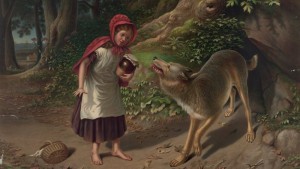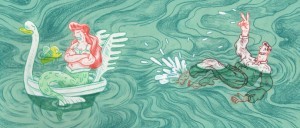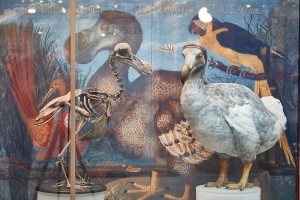Maria Tatar's Blog, page 6
April 19, 2016
Looking forward to talking Fairy Tales
Three Rivers Community College’s Booker T. DeVaughn Lecture Series will host “Wired For Weirdness: How Fairy Tales Work Their Magic,” a guest lecture by professor Maria Tatar, at noon April 20 in the college’s multipurpose room, 574 New London Turnpike, Norwic
Posted Apr. 18, 2016 at 6:00 PM
Three Rivers Community College’s Booker T. DeVaughn Lecture Series will host “Wired For Weirdness: How Fairy Tales Work Their Magic,” a guest lecture by professor Maria Tatar, at noon April 20 in the college’s multipurpose room, 574 New London Turnpike, Norwich.
The free talk will focus on the origins of fairy tales in oral storytelling cultures. It will address cultural repetition compulsion when it comes to “Little Red Riding Hood,” “Beauty and the Beast” and “Sleeping Beauty.”
Tatar is the John L. Loeb professor of Germanic languages and literatures at Harvard University.
The event is sponsored by the Three Rivers College Foundation and Dime Bank.
March 26, 2016
Finally Met Some Fairy Tales I Do Not Like
For Classic Fairy Tales, the Norton Critical Edition that I compiled some years ago, I included James Thurber’s “The Little Girl and the Wolf” in the unit on “Little Red Riding Hood.” Last year, I was invited to entertain the sons and daughters of an administrative unit at Harvard on “Take Your Kids to Work Day.” The plan was to act out different versions of “Little Red Riding Hood.” I considered Thurber’s version and then stopped short at the part where the girl whips out a gun, realizing that the parents present would not be amused. Times change, and what drew big laughs from the students in my classes 20 years ago (“she whips a pistol from her knickers”) now sends a chill down their spines (“bang bang bang, she shoots him dead”).
The small girl smiles. One eyelid flickers.
She whips a pistol from her knickers.
She aims it at the creature’s head
And bang bang bang, she shoots him dead.
A few weeks later, in the wood,
I came across Miss Riding Hood.
But what a change! No cloak of red,
No silly hood upon her head.
She said, “Hello, and do please note
My lovely furry wolfskin coat.”
The NRA has not appropriated Thurber but their new fairy tales take a perverse turn, with parents and children “enjoying” gun-friendly adaptations. Below the link to the NRA stories, with the preface, followed by a link to an NPR article about the stories.
http://www.nrafamily.org/articles/201...
Have you ever wondered what those same fairy tales might sound like if the hapless Red Riding Hoods, Hansels and Gretels had been taught about gun safety and how to use firearms? The author of this piece, Amelia Hamilton has—and NRA Family is proud to announce that we’ve partnered with the author to present her twist on those classic tales. We hope you and your children enjoy this first installment!
http://www.npr.org/sections/thetwo-way/2…
Adding guns to the world of the Brothers Grimm drastically reduces death rates, according to a study — well, OK, according to a couple of stories published by the NRA.
So far, there are only two data points. And they’re imaginary. But the trendline is clear: In the NRA’s reimagined fairy tales, putting rifles in the hands of children creates a safer world.
The NRA Family site published its first reimagined fairy tale — “Little Red Riding Hood (Has A Gun)” in January, and followed up with “Hansel and Gretel (Have Guns)” last week.
On Twitter, inspired by the series, a few people have been inventing their own #NRAfairytales, imagining tales that begin with “once upon a time” and end with a bang.
“Prince traveling kingdom 2 find owner of glass slipper shot dead by gun wielding evil stepmother,” @SarahFMcD wrote.
“The porridge was too cold, the bed was too hard, but this AK47 is just right,”@Scott_Craven2 offered. “Who’s up for some bearskln rugs?”
But the NRA’s own stories — written by Amelia Hamilton — are noteworthy for their nearly complete lack of violence.
Fairy tales, of course, were notoriously gory and grim in their original incarnations. But the NRA’s versions take place in a utopia filled with empowered and unharmed children.
March 6, 2016
“This happened, and it didn’t happen”
I’m looking fo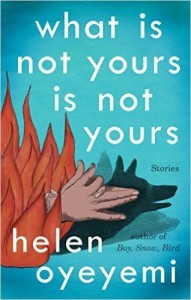 rward to reading Helen Oyeyemi’s new collection of short stories—official publication date March 7. And I love the fact that Oyeyemi uses my favorite opening line for a fairy tale: “This happened, and it didn’t happen.” Here’s one review, along with jacket copy.
rward to reading Helen Oyeyemi’s new collection of short stories—official publication date March 7. And I love the fact that Oyeyemi uses my favorite opening line for a fairy tale: “This happened, and it didn’t happen.” Here’s one review, along with jacket copy.
So it is in Oyeyemi’s What Is Not Yours Is Not Yours, a collection of stories in which elements of fairy tales, myths and legends, from Punchinello to Cupid and Psyche to Little Red Riding Hood and Bluebeard and Rumpelstiltskin, surface in curious forms in service of mystifying plots. As we’re told in the opening of the story “Drownings”: “This happened and it didn’t happen.”
http://www.dallasnews.com/lifestyles/boo…
Playful, ambitious, and exquisitely imagined, What Is Not Yours Is Not Yours is cleverly built around the idea of keys, literal and metaphorical. The key to a house, the key to a heart, the key to a secret—Oyeyemi’s keys not only unlock elements of her characters’ lives, they promise further labyrinths on the other side. In “Books and Roses” one special key opens a library, a garden, and clues to at least two lovers’ fates. In “Is Your Blood as Red as This?” an unlikely key opens the heart of a student at a puppeteering school. “‘Sorry’ Doesn’t Sweeten Her Tea” involves a “house of locks,” where doors can be closed only with a key—with surprising, unobservable developments. And in “If a Book Is Locked There’s Probably a Good Reason for That Don’t You Think,” a key keeps a mystical diary locked (for good reason).
February 12, 2016
Jesse Eisenberg tells us “Why I Broke up with the Little Mermaid”
February 10, 2016
Silenced Princesses?
Here’s the Washington Post report on research conducted by linguists Carmen Fought and Karen Eisenhauer. I can’t help but feel that sidekicks play an important role and that the next step is to analyze the data.
In the classic three Disney princess films, women speak as much as, or more than the men. “Snow White” is about 50-50. “Cinderella” is 60-40. And in “Sleeping Beauty,” women deliver a whopping 71 percent of the dialogue. Though these were films created over 50 years ago, they give ample opportunity for women to have their voices heard.
By contrast, all of the princess movies from 1989-1999 — Disney’s “Renaissance” era — are startlingly male-dominated. Men speak 68 percent of the time in “The Little Mermaid”; 71 percent of the time in “Beauty and the Beast”; 90 percent of the time in “Aladdin”; 76 percent of the time in “Pocahontas”; and 77 percent of the time in “Mulan” (Mulan herself was counted as a woman, even when she was impersonating a man).
Part of the problem is that these newer films are mostly populated by men. Aside from the heroine, the films offer few examples of women being powerful, respected, useful or comedic.
February 9, 2016
George Lucas, The Force Awakens, and Fairy Tales (and Bruno Bettelheim)
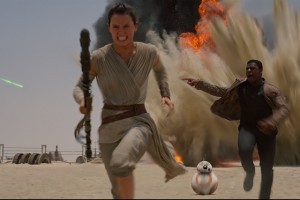 Below some ideas I cooked up while preparing for a show hosted by the supersonic Christopher Lydon on The Force Awakens. Link to the show is at the end.
Below some ideas I cooked up while preparing for a show hosted by the supersonic Christopher Lydon on The Force Awakens. Link to the show is at the end.
“The Force Awakens”: Once upon a Time
In directing the latest installment to the Star Wars films, J.J. Abrams has taken to heart Ezra Pound’s dictum to “make it new.” His requel (both a sequel and a reboot of the Star Wars films) hits the refresh button in ways that enable the franchise to live on and replicate itself for generations to come.
Like George Lucas, who sat under an oversized photo of the Russian film director Sergei Eisenstein while writing the first Star Wars film, Abrams is a master of montage. But more than that, he has taken a leaf from Lucas’s playbook and turned himself into what Claude Lévi-Strauss called a bricoleur, a mythopoeic director who takes bits and pieces of what is close at hand to create something new (it’s no coincidence that Rey is introduced as a scavenger).
“The Force Awakens” may be something new, but is it original, daring, and inventive? Did the first Star Wars film create a new mythology, as NYT film critic Roger Copeland declared in 1977, or is it just a postmodern pastiche signaling a sense of gloom and exhaustion when it comes to creativity?
Star Wars has always had a self-reflexive edge—what goes by the name of “meta” these days. It is a mash-up of space opera, samurai movie, western, and war film, also paying homage to films and television productions ranging from The Wizard of Oz and Flash Gordon to Casablanca and Metropolis. In its most recent iteration, it engages in a sly nudge, nudge, wink, wink game of self-referential jokes, as in the golden moment when Harrison Ford turns to his furry sidekick and says, “Chewie, we’re home.”
“I don’t think I’ve ever come across anyone so immersed in film. I have an idea he goes to bed in it, wrapped up in it, you know, the actual material.” Alec Guinness was not joking when he described his friend George Lucas as a man devoted to his craft. Is it any surprise that Lucas would make a richly allusive series of films that recycle the tropes and give a tip of the hat to the films he loved? And the Star Wars films, unlike many other cinematic franchises including Harry Potter, Jurassic Park, the Hunger Games, Lord of the Rings, and the Twilight saga, has no real textual story base—even if Lucas claimed that his real inspiration came from reading comic books as a ten-year-old.
Still, there is also a dark side (as it were) to all the talk about postmodern playfulness and sophisticated hyper-referentiality in the Star Wars film. “You can type this shit, George, but you sure can’t say it,” Harrison Ford complained on set to the director. The film has also been seen as a mélange of dreadful dialogue, flat characters, and absurd sidekicks and gizmos with narrative circuits as banal as they are borrowed. Consider the opening crawl: “Rebel spaceships, striking from a hidden base, have won their first victory against the evil Galactic Empire.”
Now a Disney franchise, The Force Awakens does what Disney does supremely well, turning itself into a platform for selling toys and costumes. Even before Disney, toys were a regular part of the Star Wars world and wookiees coexisted peacefully with storm troopers in the long lines on opening night for each new episode.
Blame it on Joseph Campbell if Star Wars fails to deliver fully on the promise of a new mythology. Or can we? The Golden Bough, a study of mythic beliefs by the Scottish anthropologist Sir James George Frazer, was evidently also on Lucas’s reading list, even while he was poring over Campbell’s The Hero with a Thousand Faces and learning about the twelve-step program for the Hero’s Journey.
“Look around you, ideas are everywhere,” George Lucas once said, and it soon becomes clear that he was never just a cinephile. When he claimed to be building “something unusual” about “whatever was to hand,” he was thinking in the broadest possible terms. While working on the third draft of the Star Wars script, he read Campbell and decided to make his film fit more into “the classic mode.” But he was also reading Bruno Bettelheim’s Uses of Enchantment, which championed the therapeutic value of fairy tales (and read many of the stories as enactments of Oedipal dramas). Channeling Bettelheim, he worried that there was “a whole generation growing up without any kind of fairy tales, and kids need fairy tales.”
“Young people today don’t have a fantasy life anymore, not the way we did,” Lucas once stated. “All they’ve got is ‘Kojak’ and ‘Dirty Harry.’ . . . All the films they see are movies of disasters and insecurity and realistic violence.” Young people, he added, no longer have fairy tales.
Children, like adults, need symbolic worlds in order to navigate the real, and fantasy can be the place where they are most at home. We may dismiss them as escapist fictions, forgetting that jailers are the only ones against escape. Quest narratives give us something primal: heroic figures suffering from nostalgia, uprooted from a world that has turned toxic and in search of a new place to call home.
It was the genius of George Lucas to create a “once upon a time” that is long ago and far away, not in the here and now, and not even on planet Earth. “I put this little thing on it: “A long time ago in a galaxy far, far away . . . .’ Basically it’s a fairy tale now. Star Wars is built on top of many things that came before. This film is a compilation of all those dreams, using them as a history to create a new dream.”
Watching the films today, you never quite know where you are, a fact that goes far toward explaining the film’s global appeal. Mix universal applicability in with a palliative narrative that is cozily familiar and filled with hi-tech wizardry and low-tech gags (where else can you fix a space ship with a screwdriver?), and you suddenly have a generational totem for the ages. In the decades to come, the conflicts between the Rebel Alliance/Resistance and the Empire/First Order will remain as robust as the domestic drama that pits father and son against each other.
http://radioopensource.org/our-postmoder…
February 8, 2016
Andersen’s ‘The Most Incredible Thing’ Revived at the Ballet
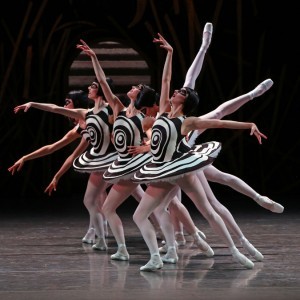 Hans Christian Andersen’s “The Most Incredible Thing” was the Danish writer’s favorite fairy tale, but it is rarely brought back to life. Alastair MacCaulay reviewed the NYC ballet production inspired by the story and found it wanting, but the photographs and video send a different message.
Hans Christian Andersen’s “The Most Incredible Thing” was the Danish writer’s favorite fairy tale, but it is rarely brought back to life. Alastair MacCaulay reviewed the NYC ballet production inspired by the story and found it wanting, but the photographs and video send a different message.
As I noted in my Annotated Hans Christian Andersen, the story was reprinted by a group of academics who became leaders of the Danish Resistance Movement and illustrated in a way that made it an allegory of Nazi defeat.
When the Destroyer arrives, he’s wonderfully arresting. Like the god Janus of Roman mythology, he has two faces, one on the back of his head. He, in everything he does, is the most real person in the piece.
http://www.nytimes.com/2016/02/04/arts/d…
November 15, 2015
Oxford and Wonderland
Fantastic as it was, “Wonderland” was rooted in the place Dodgson lived and worked: the city and environs of Oxford with its ancient university, its “dreaming spires” and its surrounding countryside. Oxford is a city teeming with tourists and traffic, whose shop windows, in the sesquicentennial year of “Wonderland,” overflow with Alice merchandise; but if one listens closely, if one ducks through stone arches, opens creaky oaken doors, and descends to quiet riverside paths, one can still find the Oxford of Charles Dodgson and Alice.
November 8, 2015
Michael Cunningham’s A WILD SWAN
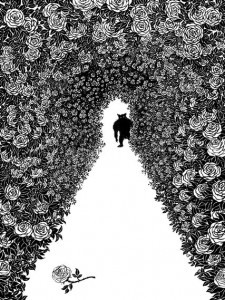 Here’s Christopher Benfey on Cunningham’s new book of fairy tales reimagined:
Here’s Christopher Benfey on Cunningham’s new book of fairy tales reimagined:
Not all ugly ducklings turn out to be swans. Not all frogs are enchanted princes. And perhaps it’s best that way, as Cunningham notes in “Dis. Enchant,” his humane and rueful prologue: “If certain manifestations of perfection can be disgraced, or disfigured, or sent to walk the earth in iron shoes, the rest of us will find ourselves living in a less arduous world; a world of more reasonable expectations; a world in which the appellations ‘beauty’ and ‘potency’ can be conferred upon a larger cohort of women and men.” Who needs three wishes anyway? “Most of us can be counted on to manage our own undoings.”
October 7, 2015
Circle & Yearn in the Wizard of Oz
nbsp;http://www.pbs.org/newshour/bb/rainbow-t…
ROB KAPILOW, Composer: You know, amazingly, the answer to that starts with the very first two notes. In this famous opening idea, there’s really only two ideas. One of them, I call leap. The other one, I call circle and yearn. And it’s important.
(CROSSTALK)
JEFFREY BROWN: Leap and circle and yearn.
ROB KAPILOW: It’s important you learn these technical terms, Jeffrey.
JEFFREY BROWN: Oh, I see.
ROB KAPILOW: Circle and yearn.
So, it starts off with this.
JEFFREY BROWN: I didn’t learn that with piano lessons, by the way, right?
ROB KAPILOW: It’s time.
We start off with this big leap. This is a full octave leap. That’s a big leap for a popular song. In fact, producers were worried that nobody would buy the song because it would be too hard to sing this opening leap.
Now, this leap isn’t just a big leap musically. It’s a leap between two different worlds and two parts of the voice. The first note is kind of low down there in chest voice. It’s Dorothy’s troubled reality. It’s Kansas, aridity, no flowers. It’s the black and white of the beginning of the film.
Maria Tatar's Blog
- Maria Tatar's profile
- 316 followers


